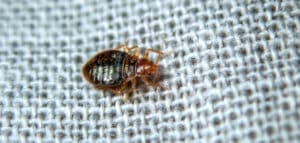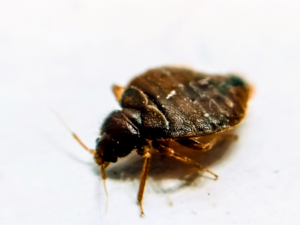Bed Bug Facts & Information
Hawx is always reliable. Always innovative.
20,000+ 5-STAR REVIEWS
“Connors Trader went the extra mile to make sure he listened to our needs regarding the ant problem we had.”
- Larry
“He sprayed indoors and out, swept my eaves for spider webs and took care of a couple of wasp nests.”
- Rick
“He even sprayed on my deck, which no one else has done.”
- Sue

Bed bugs are the last thing anyone wants to find in their home—even the mere idea of them can be unsettling. These tiny, elusive insects can disrupt your routine and leave you feeling anxious about what’s hiding in your sheets. But what can you do to get rid of bed bugs and prevent them from coming back?
Let’s go over what bed bugs are, how to spot them, and the best strategies for getting them out of your home.
Look up your local branch or call our office at (888) 372-9514 to schedule your appointment.
What Are Bed Bugs?
Bed bugs are tiny, parasitic insects that feed on the blood of humans (and occasionally warm-blooded animals). In recent years, they’ve become a bigger concern due to things like increased global travel and changes in pest control practices. Because bed bugs are nocturnal, they typically emerge at night to feed and hide in crevices by day—such as mattress seams, bed frames, and even electrical outlets.
They’re able to reproduce quickly, with females laying multiple eggs per day. Newly hatched bed bugs are called nymphs and go through several growth stages before reaching adulthood, each requiring them to feed on blood. Under the right conditions, they can mature in about a month.
To make matters worse, bed bugs are very hardy and can survive for months without feeding if they find a cozy hiding spot.
What Do Bed Bugs Look Like?

Bed bugs are oval-shaped, have flattened bodies, and measure about 5 to 7 millimeters in length when unfed—about the size and shape of an apple seed. Before feeding, they’re light brown, but once they feed, they become rounder and shift to more of a darker, reddish-brown color. Bed bugs have no wings, so they rely on crawling or hitchhiking to move from place to place, often sneaking into homes via luggage, clothing, or secondhand furniture (sorry, thrift shop enthusiasts).
To confirm you’re seeing bed bugs and not some other insect, inspect the seams and folds of your mattress and check the corners of your bed frame. A flashlight can help you spot their tiny bodies more easily, especially if you think they’re hiding in cracks.
What Do Bed Bug Bites Look Like?
Most people only discover a bed bug problem after noticing itchy bites that appear overnight on exposed skin like the arms, legs, neck, or face. Bed bug bites typically appear as red, raised welts or small clusters of bumps. Some people experience more significant swelling or itchiness than others, but others may not react at all. These bites can be mistaken for mosquito bites or other insect bites, so it’s important to check for additional clues around your sleeping area to be sure.
Signs of Bed Bugs in Your Home
There are several relatively clear indicators that you have a bed bug problem. Here are a few ways for how to tell if you have bed bugs:
- Rusty or reddish stains: Small blood spots on your sheets or pillowcases, which can occur if you roll over and crush a bed bug.
- Dark smears or specks: Fecal matter from bed bugs resembles tiny black dots, usually found along mattress seams or behind headboards.
- Tiny white eggs: These can be challenging to spot on most mattresses. They often appear along seams or in tight crevices.
- Shed skins: Bed bugs shed their exoskeletons as they grow, leaving behind translucent shells.
- Sweet, musty odor: Large bed bug infestations can produce a distinctive, sort of musty scent.
If you see these warning signs of bed bugs, check your bed frame, box spring, and any nearby furniture. They are small and stealthy, so be thorough with your inspections so you don’t overlook them.

“There are 3 main misconceptions about bed bugs:
1. They don’t live on people. They approach, feed, and disappear. Bed bugs are considered nocturnal because that’s when people are still.
2. They’re not social. They happen to group together because that’s where the food is. In fact, they give off aggregation pheromones (simeo-chemicals) in their stool, which signals to other bed bugs that they’ve found food.
3. Bed bugs have not been shown to transmit organisms that transmit disease. But they can cause anxiety, disrupt sleep, and cause true mental distress. Call Hawx right away if you suspect bed bugs in your home. ”
Vice President of Technical & Training Services, Entomologist
How to Get Rid of Bed Bugs
Ridding your home of bed bugs is rarely straightforward. Their size and choice of hiding spots make them hard to spot at first, giving them time to reproduce and cause a bigger infestation.
Here are some common methods for addressing a bed bug infestation:
- Deep cleaning: Wash all bedding, curtains, and clothing in hot water, then dry on the highest heat setting. Vacuum mattresses, floors, and furniture thoroughly.
- Seal entry points: Use caulk or other sealants to close gaps around baseboards, headboards, and bed frames where bugs can hide.
- Encasements: Mattress and box spring encasements can trap bed bugs inside.
- Heat treatments: Raising the temperature in infested areas above 120°F for several hours on end can kill bed bugs at all different life stages.
- Chemical treatments: Over-the-counter insecticides or DIY solutions can help reduce the population but will likely fail to affect any bed bugs hidden in crevices or elsewhere.
While home remedies and store-bought products offer short-term relief, bed bugs can survive in the smallest crevices and reboot the infestation. Professional pest control services are always the most effective route for complete extermination. These experts can identify hidden breeding spots and apply targeted treatments that wipe out even the most stubborn colonies of bed bugs.
Let Hawx Handle Your Bed Bug Problem
Although bed bugs don’t spread disease, they can create a lot of stress, plenty of discomfort, ongoing skin irritation, and even welts. If you suspect bed bugs have taken over your living space, DIY approaches may only offer temporary relief, if any at all.
At Hawx Pest Control, we know how to spot infestations quickly and treat them effectively so you can sleep soundly, knowing your home is free of these tiny yet troublesome bugs. Our skilled technicians provide comprehensive services that target bed bugs where they hide, ensuring thorough coverage and minimal risk of resurgence.
Contact Hawx Pest Control today for a detailed inspection and personalized treatment plan that will eliminate bed bugs and give you back your comfort and peace of mind.
Read more about bed bugs

From Itch to Epidemic: Online Searches for Bed Bug Treatments Soar 311% Across Texas
A new study by Hawx Pest Control reveals a significant surge in the number of Texans affected by bed bugs. In August, statewide Google searches

The Dangers of DIY Bed Bugs Removal: Why Professional Help Is Essential
The Dangers of DIY Bed Bugs Removal: Why Professional Help Is Essential If you’ve ever dealt with bed bugs, you know how frustrating—and exhausting—they can

Infested Toys: How to Get Rid of Bed Bugs in Stuffed Animals
Bed bugs can nest inside a surprising number of spots inside your home. Although these creatures are known for infesting beds and hiding inside mattresses,
To learn more about our home pest control or commercial pest control services, please reach out to Hawx Pest Control today!



